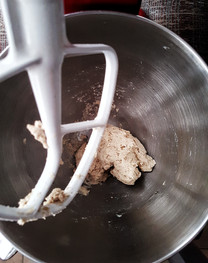Homemade Ravioli (Gluten Free and Vegan)
- Moy's Gluten Free Kitchen

- Jun 7, 2019
- 3 min read
Updated: Aug 14, 2021
I really fell in love with pasta as an adult. As a child our pasta dishes were limited to macaroni pie (baked mac & cheese), the occasional lasagna, Chinese styled noodles and spaghetti with meat balls (or meat sauce).
Later on I was introduced to other pasta dishes and even later on I started experimenting with various types of pasta. Pappardelle, gnocchi, cannelloni and ravioli were all somewhat new to me as a young adult.
We also never made homemade pasta. Looking back that seems weird for a family where cooking was a passion and a business.
Fast forward to the present and pasta meals are somewhat of an indulgence for me. I make pasta like comfort food, rich, layered and delicious. I worry less about it being healthy and more about it being satisfying, the kind of satisfying that makes you moan in delight.
This means that sometimes I have to make certain types of pasta from scratch if I want to eat it, like Ravioli. Apart from not being able to readily source it, Ravioli is just better fresh. I can also make whatever filling I fancy.
My recipe here focuses on the ravioli dough. I use quinoa and oat flour because they hold up well when rolling out and when boiling. Qunioa also gives the ravioli a bit of chewiness, which I happen to like. You could also say that using Quinoa and Oat flour makes this ravioli healthier!
I do not use a pasta machine, I roll out the dough with a rolling pin. Once my work surface is liberally dusted with flour I get little trouble making the ravioli.
A word of caution with your filling. Try not to use a chunky filling or a "liquidy" filling. As good as the dough holds up it is still gluten free and also vegan. The dough can tear if handled incorrectly.
All you have to do now is give it a try, enjoy!


Gluten Free, Vegan Homemade Ravioli Recipe
Ingredients
½ cup oat flour
¼ cup quinoa flour
¼ cup tapioca starch (more for dusting)
¼ tsp salt
½ tsp xanthan gum
½ tsp brown sugar
½ tbsp olive oil
½ cup water
Directions
Make the dough
Combine the dry ingredients
Add the oil and water. Knead or mix to form a firm but not dry dough, adding more water by tablespoon if needed. Once combined use wet hands to press the flour mixture into a rough ball.
Divide the dough into four pieces and knead each to form a ball as smooth as you can make it. Work with oiled or flour dusted hands. Use as much time as needed to work the dough until smooth, you do not have to be worried about overworking the dough. When you are finished with each piece, cover with oiled plastic wrap and set aside for about 30 minutes.
While the dough is resting, prepare your filling of choice and set aside
Roll out the pasta
On a surface sprinkled with tapioca starch carefully roll out the ball into a rectangle about 1/16 – 1/8 inch thickness and 2 ½” width. Keep checking the underside of the dough as you roll out to ensure that it is not sticking to the surface, flip and dust with more flour if needed. Repeat with a second piece of dough (try to roll out the rectangles to about the same size).
Fill the pasta Bring a large pot of lightly salted water to a boil
Using a 2” round biscuit cutter, lightly score circular shapes center and along the length of one rectangle. Drop teaspoonfuls of the filling in the center of each circle. Brush the edges with a little water. Lay the second rectangular sheet over the one with the filling attempting to match up the edges as evenly as possible
Gently smooth out the pasta, working from just around the filling and pushing toward the edges to remove any air bubbles and wrinkles. Use the 2” round biscuit cutter to cut out the ravioli then seal the edges completely
Add ravioli to the boiling water and cook for 5 to 7 minutes or until the ravioli floats to the top. Do not boil too many at once. Remove with a slotted spoon and drain in a colander. If needed you can spread olive oil over the ravioli to prevent them from sticking together
Best served immediately
Notes
The ravioli can be cut into squares or more complex shapes, adjust the width of the rolled out dough and the spacing of the filling accordingly.
The dough can be rolled out between two sheets of plastic wrap. The plastic wrap also helps with handling the sheets of pasta. Use it to pick up and place one sheet of pasta over the other.
To make it easier you can use smaller pieces of dough at a time, just remember to keep unused portions of the dough covered and moist.












Comments